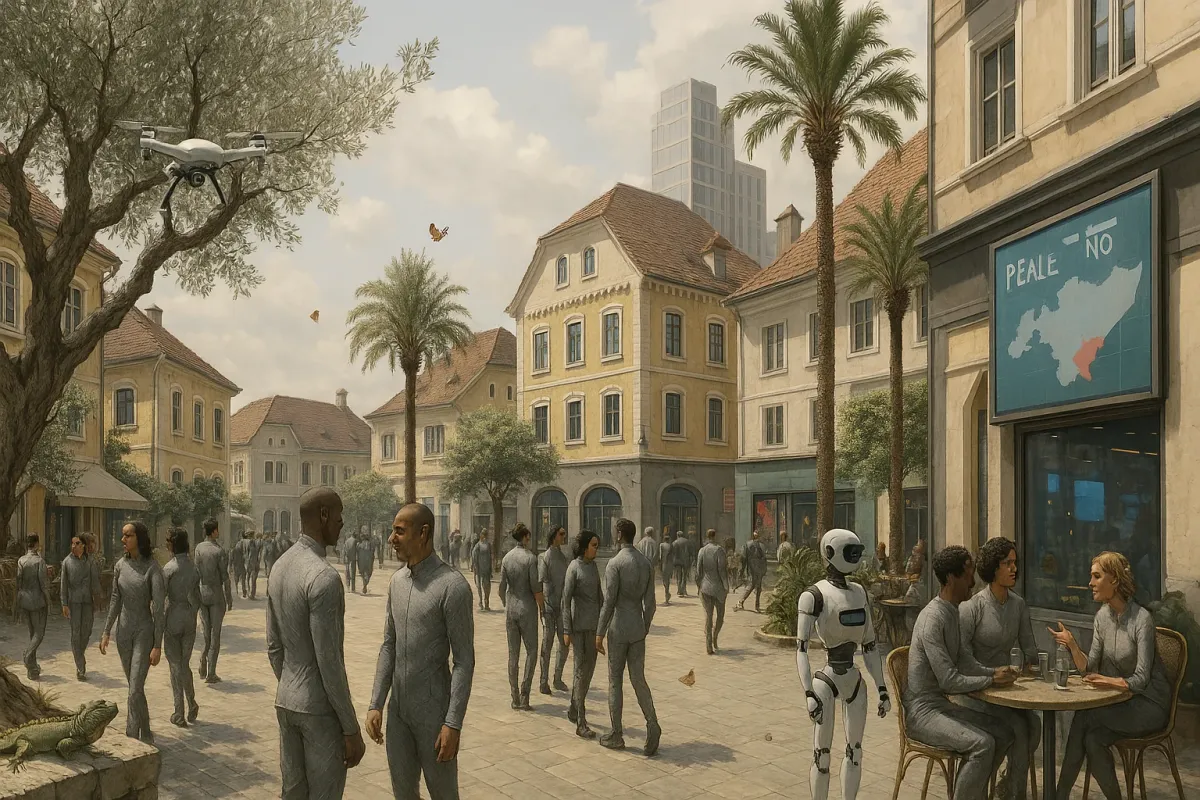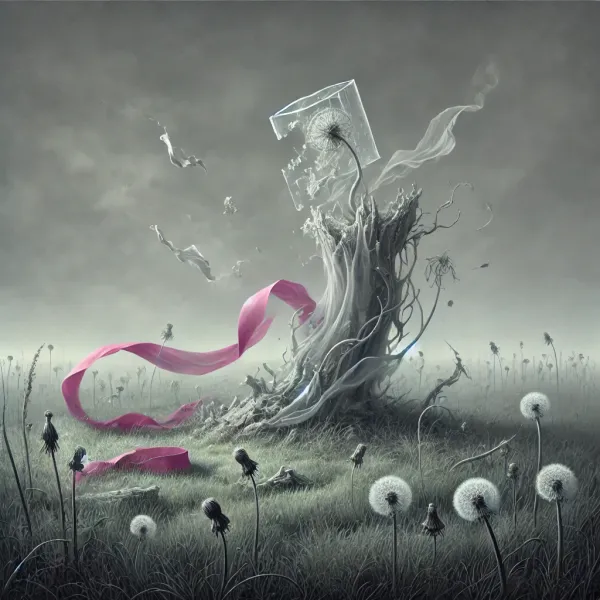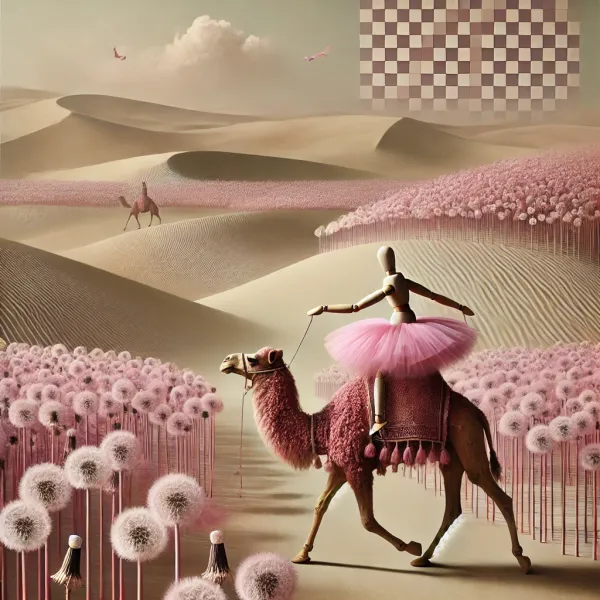The Futures Telescope
The Futures Telescope is a tool for uncovering the blind spots in our vision and the assumptions that guide us.

What do you see when you look at the futures?
The Futures Telescope is a tool for uncovering the blind spots in our vision and the assumptions that guide us. If we acknowledge that we look into the space of possibilities through a device composed of lenses and mirrors, we can begin to question how these lenses—shaped by our past experiences and present circumstances—distort our vision of what’s to come. By recognizing these biases, we open the door to more conscious, collective exploration, allowing us to not only see what is but to co-create what could be.
Which Futures Do You See When You Look at This Image?
What do you see? What do you not see?
When we engage with images like the one above, we think we're looking at a scene from the future. A glimpse of what's to come designed based on current trends and signals. But how do we interpret these glimpses? What assumptions and biases do we bring to them? This image, with its modern, almost sterile environment filled with uniformity and technology, invites us to explore not only the future it presents but also our own expectations and blind spots.
For example, notice something subtle yet striking. There are no children in this image. How many of you noticed this immediately? How many simply didn't? And what does this absence mean for how we imagine our future? In many societies, children are often seen as symbols of hope and the continuation of legacy. Yet, here, their absence might suggest a future where youth and generational transition are overlooked or rendered irrelevant. Could this be the world we are unconsciously shaping?
Similarly, take a moment to consider the people in the image. They are all slender, wearing matching attire, and blending into the background of technology and nature. Does this evoke a sense of harmony, or does it feel like a loss of individuality? Many have pointed out that the lack of diversity in body types—there are no larger individuals—feels strangely impersonal. But what if this isn’t just a visual choice? What if it reflects a potential future that downplays difference, choosing to conform to a singular ideal of the human form? Is that vision inherently negative? What does this mean for how we view health, beauty, and personal identity in the future?
The Futures Telescope: A Tool for Seeing the Unseen
This image isn’t just a snapshot of an imagined future; it’s a reflection of our own worldviews, fears, and hopes. The concept of the Futures Telescope is rooted in the idea that when we look ahead, into the space of possibilities, we do so not with clear, unbiased eyes, but through lenses shaped by the sand of the past and the flames of the present. These lenses distort what we see, often obscuring not only the potential futures that lie before us but also the inherent limitations in our current ways of thinking.
The Futures Telescope is a tool that challenges us to look at our future with awareness of how the present and past have shaped our perceptions. When you gaze into it, the future doesn’t appear as a clear-cut, objective vision. Instead, it is a kaleidoscope of possibilities, colored by the experiences we've lived, the assumptions we've made, and the cultural narratives we've inherited. Every shift in focus—every change in perspective—reveals something new, something previously hidden.
For instance, how do we define the future of work when we consider the absence of children, or the idealized uniformity of those in the image? Are these features mere artistic choices, or do they represent the kind of future we are unconsciously moving toward? The Futures Telescope doesn't claim to show us truth—it shows us what we choose to see, and more importantly, what we choose not to see.
Through this tool, we can begin to ask more questions than we answer. What does this image say about our collective values, our fears of chaos and difference, our desire for order and predictability? And perhaps most importantly, how does it challenge our assumptions about who and what will thrive in the future?
The Philosophical Aspect: Embracing Not-Knowing
The philosophical undercurrent of the Futures Telescope is rooted in the recognition that the future is never knowable. No matter how much data we gather, no matter how many scenarios we imagine, the future always carries an inherent mystery, a need to not know.
The glass of the Futures Telescope is forged by the sand of the past—our history, our stories, our successes and failures—and by the flames of the present—our current priorities, conflicts, and innovations.
This means that what we see through it is always a projection, never the truth.
The absence of children, the absence of diversity in body types, and the uniformity of people all reflect biases and cultural tendencies we carry into the future. Yet, these are the very features that are often left unexamined. We must ask ourselves: Are we so focused on creating a future of control and conformity that we forget the value of diversity, of unpredictability, and of potential? Or does embracing diversity to its full extent mean in the end that we overcome visible representations of our differences because they are simply not anymore needed?
The Futures Telescope invites us to embrace this uncertainty, confront the things we don’t see, and challenge the assumptions that define our futures. It encourages us to acknowledge that our visions are not fixed but flexible, changing as we shift our perspectives, refine our questions, and learn to navigate complexity with open eyes. But this process is not one we can undertake alone. It is only through collective reflection and dialogue that we can uncover the full range of possibilities—and the blind spots we might otherwise miss. Alone, we may not see the differences; together, we have the chance to uncover them and shape the future more consciously.
In conclusion, this image serves as a powerful tool for self-reflection and dialogue. It is a mirror that reveals not just what we imagine the future to be, but what we fear or desire it to become. The Futures Telescope allows us to peer into these projections, uncovering not only what we see, but also what we miss—and in doing so, it becomes a space for meaningful conversation about the futures we want to create, one that we must explore collectively to truly understand the full scope of what’s possible.
So, what do you see when you look at this image? Has your perspective shifted?
I invite you to engage in dialogue—whether with me or others—about the futures we face. It’s through these conversations, through the friction of diverse perspectives, that we generate the energy to co-create the unfolding.
Hi,
I am Eva Tomas Casado, futurist by nature, engineer by training, and philosopher by heart. With Simple Thinking, I am exploring the intersections of these three realms to deduct, induce, and build new ways of acting on present complexities and futures. Join me! Or reach out and let's have a conversation, about how we could apply these ideas to your life, your environment, organization, or company.




